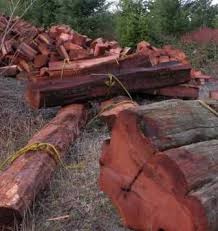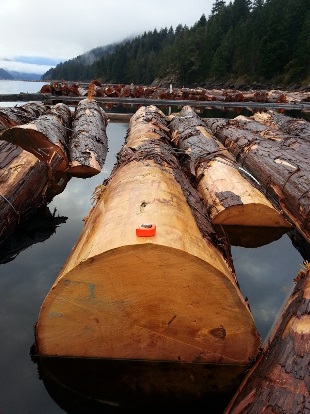Both Western Red Cedar and Yellow Cedar are exceptionally durable and weather resistant. After being sustainably harvested they have very pleasant aromas, and are very commercially valuable. Although Western Red Cedar has the longest life span of any tree in British Columbia, the Yellow Cedar is also known for its longevity. Both woods are filled with natural preservatives called tannins, giving them great durability. These natural preservatives repel against moisture, insects, and decay.
 Western Red Cedar is a softer and more lightweight wood than Yellow Cedar. It’s more tonal, being known for it’s warm colour and dark, rich heartwood. It is commonly used in log homes because of the flare at the bottom of the trunk, and the fact that it’s a great thermal insulator. Western Red Cedar is excellent at absorbing stain since it is a softwood and is also pitch and resin free, so it works great both internally and externally. The most common uses are decking, fences, posts, and beams.
Western Red Cedar is a softer and more lightweight wood than Yellow Cedar. It’s more tonal, being known for it’s warm colour and dark, rich heartwood. It is commonly used in log homes because of the flare at the bottom of the trunk, and the fact that it’s a great thermal insulator. Western Red Cedar is excellent at absorbing stain since it is a softwood and is also pitch and resin free, so it works great both internally and externally. The most common uses are decking, fences, posts, and beams.
 Yellow Cedar which has many different names such as Alaskan Yellow Cedar and Sitka Cypress is a much harder wood than Western Red Cedar. It’s actually a Cypress tree and not a Cedar. It’s used for building aspects where strength and durability are key factors. It usually grows at high altitudes, causing fine grain with tight growth rings. It takes nails and screws without splitting, and very rarely twists. Since the wood is harder and filled with tannins, it’s not as absorbent with stain. Boat building, bridges, and stairs are common uses for this type of wood since it’s so dense and strong. Yellow Cedar is harvested in much smaller quantities than Western Red Cedar.
Yellow Cedar which has many different names such as Alaskan Yellow Cedar and Sitka Cypress is a much harder wood than Western Red Cedar. It’s actually a Cypress tree and not a Cedar. It’s used for building aspects where strength and durability are key factors. It usually grows at high altitudes, causing fine grain with tight growth rings. It takes nails and screws without splitting, and very rarely twists. Since the wood is harder and filled with tannins, it’s not as absorbent with stain. Boat building, bridges, and stairs are common uses for this type of wood since it’s so dense and strong. Yellow Cedar is harvested in much smaller quantities than Western Red Cedar.